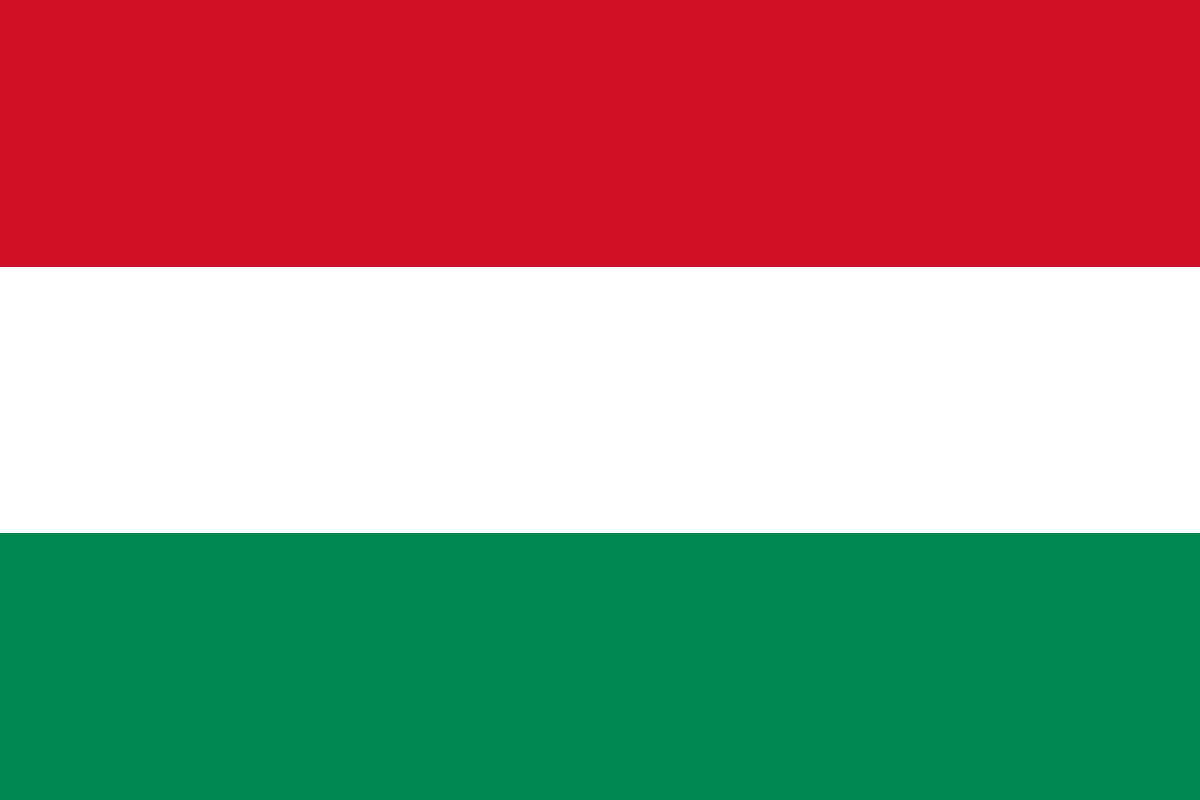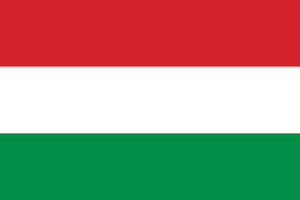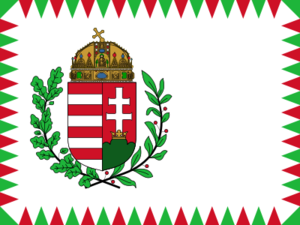- Flag of Hungary
Nickname =
Morenicks =
Use = 110000
Symbol =
Proportion = 1:2
Adoption =
Design = horizontal tricolour of red, white and green
Designer =
Nickname2 =
Morenicks2 =
Use2 = 010000
Symbol2 =
Proportion2 = 1:2
Adoption2 =
Design2 = Hungarian flag with current official Hungarian coat of arms. Legal whenever a person or institution is eligible to use the official coat of arms by law (e.g. MPs, members of government, ministries, etc.).
Designer2 =
Nickname3 =
Morenicks3 =
Use3 = 001000
Symbol3 =
Proportion3 = 3:4
Adoption3 =
Design3 =
Designer3 =
Nickname4 =
Morenicks4 =
Use4 = 000100
Symbol4 =
Proportion4 = 2:3
Adoption4 =
Design4 =
Designer4 =
Nickname5 =
Morenicks5 =
Use5 = 000001
Symbol5 =
Proportion5 = 3:4
Adoption5 =
Design5 =
Designer5 =The
flag ofHungary is a horizontaltricolour ofred ,white andgreen . In this exact form, it has been the official flag of Hungary since October 1, 1957.Origin
Today's flag of Hungary stems from the national freedom movement before 1848 which climaxed in the 1848/49 revolution, which was not only a revolution against the monarchy and to constitute a republic, but also a national movement against the
Habsburg s.Thus, the tricolour feature of the flag is based on the French flag and the ideas of French revolution, while the colours red, white and green were taken from the historical coat of arms. The coat of arms first appeared in the form, which is but for minor details basically the same as nowadays in the mid-15th century, marshalled from arms that first appeared in the late-12th and early-13th century as arms of the Árpáds, Hungary's founding dynasty.In sum, the Hungarian flag has its origins in the national republican movements of the 18th-19th century (concerning its form, the tricolour) and in the Hungary of the Middle Ages (concerning its colours).
Folklore of the romantic period attributed the colours to virtues: red for strength, white for faithfulness and green for hope. Alternatively, red for the blood spilled for the fatherland, white for freedom and green for the land, for the pastures of Hungary.
Historical flags of Hungary
As described above, the red-white-green tricolour has emerged as sign of national souverenity during the 1848/49 revolution against the Habsburgs. After the revolution was defeated, the flag was prohibited by the Austrian Emperor.
Only after the Compromise of 1867 did the red-white-green tricolour became not only legal, but also the official flag of Hungary. The flag had the so called "minor arms" of Hungary with archeangels as supporters were used as a badge on the flag. This configuration was used until the end of the Habsburg Empire in 1918.
After the fall of the Habsburg Empire the years 1918 to 1920 were highly turbulent, and several hard-to-trace minor changes might have taken place. Basically, the red-green-white tricolour had stayed the same for sure, differences might have occurred in terms of the badge. A short interlude and exception was the 1919 Hungarian Soviet Republic, which lasted only about 100 days: they used the solid red banner. (Include information, if you have exact ones, on this period).
It seems, that from 1920-1944 or 1945 the tricolour with the "minor arms" of Hungary, but without supporters was used.Fact|date=October 2007
Between 1946 and 1949 the crown from top of the arms serving as the badge was removed.
In 1949 the new Stalinist Hungarian arms were placed on the flag as the badge.
During the anti-Soviet uprising in 1956, revolutionaries cut out the Stalinist emblem and used the resulting tricolor with a hole in the middle as the symbol of the revolution. For some months the new government changes the flag to bear the "minor arms" without the crown as the badge again.
After the revolution was defeated by the Soviet Red Army, during the communist restoration, in 1957 the communists created a "new" coat of arms but it was never officially put onto the flag of Hungary. Therefore the official flag of Hungary has been a pure red-white-green tricolour since 1957.
After the fall of communism in 1989 there was no need to change the flag, as it did not bear any communist insignia.
There was a recommendation of the Committee of Symbols some years ago, that the coat of arms should be part of the state flag, while the national flag should not (as is the status quo). This has legally not been implemented, though in case of most state use the arms might be used on the flag (see below).
Exact description
The constitution does not state anything about the width:length ratio of the flag.However, (According to FOTW, see External Links) there is a law from 1957 which appears to be valid. It states that sea-going merchant vessels shall hoist the red-white-green tricolour in 2:3 ratio.
By a government decree from 2000, the ratio (which is neither defined in the Constitution, nor the 1995 or 2000 law (see External Links)) of flags used on government building is 1:2.
This would mean:
* A red-white-green tricolour. Many variations might be used though according to 1995/LXXXIII §11 (3) "(3) In cases specified in paragraphs (1) and (2), the arms and the flag can be used also in their historical forms." - 1995/LXXXIII §11 (1) "(1) For the purpose of declaring the pertainance to the nation, private persons can use the arms and the flag, keeping the limitations contained in this law."
* red-white-green tricolour, ratio 1:2 (by decree from 2000). According to 1995/LXXXIII §11 (4), the official coat of arms of Hungary might be placed onto it as a badge.
* White background with green red alternated flammulette ("flame tongues", triangles with wavy edge) border, coat of arms in the center, embraced by oak-branches from the left, olive branches from the right. Ratio not defined. ( 1995/LXXXIII §8 (1) )
* 2:3 (ratio defined by 1957 law) red-white-green tricolour (there is a merchant fleet)
* Unknown
* White background with green red alternated triangle border, coat of arms at 1/3 of the flag, nearer to the pole. Ratio not defined. ( 1995/LXXXIII §8 (2) )External links
*
* [http://flagspot.net/flags/ Flag of Hungary at Flagspot.net]
* [http://www.parlament.hu/alkotmany/alkotm.htm The Constitution of the Hungarian Republic (=Law 1949/XX)]
* [http://www.complex.hu/kzldat/t9500083.htm/t9500083.htm Law 1995/LXXXIII]
* [http://www.complex.hu/kzldat/t0000038.htm/t0000038.htm Law 2000/XXXVIII]
Wikimedia Foundation. 2010.


.png)


